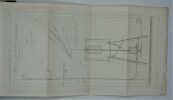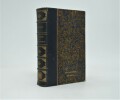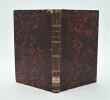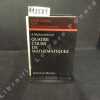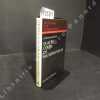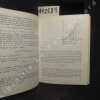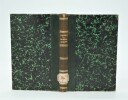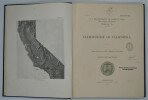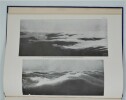-
Language
English (3)
French (58)
German (1)
Italian (2)
-
Century
18th (3)
19th (26)
20th (26)
-
Countries
Denmark (6)
France (57)
Switzerland (1)
-
Syndicate
ILAB (11)
SLAM (5)
LECONS sur la THEORIE des EQUATIONS SELON GALOIS
Un ouvrage de 382 pages, format 165 x 250 mm, relié, publié en 1997, Editions Jacques Gabay, collection "Les Grands Classiques Gauthier-Villars", bon état, rare
Précédées d'une Introduction à la Théorie des Groupes, suivies d'un Appendice sur Evariste Galois et le Théorie des équations algébriques
Phone number : 04 74 33 45 19
Mémoire sur le calcul des perturbations qu'éprouvent les comètes , Extrait du Suppléments aux comptes rendus des séances de l’académie des sciences, tome 1er
Paris , imprimerie Mallet-Bachelier , 1853 , in-4° , 258pp , relié demi veau époque , dos lisse avec auteur et titre , cachet ,un plat détaché , manque au dos.
Première impression des mémoires de Hansen, exposant sa théorie des mouvements perturbés des comètes. "Si modeste que fût la position publique qu'occupait Hansen, il peut maintenant être considéré à juste titre comme le plus grand maître de la mécanique céleste depuis Laplace. Dans quel ordre Leverier, Delaunay, Adams, et Hill devraient le suivre, il n'est pas nécessaire de décider. Pour beaucoup de lecteurs, il semblera singulier de placer un nom avant celui du maître qui a indiqué la position de Neptune avant qu'un œil humain ne l'ait jamais reconnu. Mais ce l'accomplissement, si grand qu'il fût, était plus remarquable par son audace et son éclat que par sa difficulté inhérente. Si le travail devait être refait aujourd'hui, il y a un certain nombre de jeunes gens qui auraient autant de succès que Leverrier ; mais il y a aucun qui tenterait de réinventer les méthodes de Hansen, ou même de les améliorer radicalement."( Simon Newcomb "Reminiscences of an Astronomer",New York, 1903, p.315). Directeur de l'observatoire de Seeberg ,le problème de l'astronomie dynamique occupe une grande partie de l'attention de Hansen. Le mémoire sur les perturbations des trajectoires de comètes est récompensé par l'académie de Paris en 1850. P2-6E
Physique moléculaire. Matière et énergie.
Paris, Hermann, 1933 in-8, 436 pages, 91 figures dans le texte ,relié demi cuir , dos lisse avec auteur et titre , couverture frottée , cachet
«Ceci est un magnifique traité de chimie physique ,traité très éclectique et très philosophique , imprégné des idées monadologiques de Leibnitz, qui ne propose pas de construire l’univers selon des principes et des éléments inertes mais d’après des conception qui, pour être élémentaire , n’en sont pas moins grosses de tout développement et de tout devenir» A.Buhl (L’enseignement mathématiques, 1933) Victor Henri (6 juin 1872 – 21 juin 1940) est un chimiste-physicien et un physiologiste français. P2-5C
Mémoire sur la thermodynamique
Paris , Gauthier-Villars , 1867 , in-8 , 172 pp , illustré de 2 planches dépliantes in-fine , relié demi-veau époque , dos lisse avec auteur et titre , «extrait des annales de chimie et physique , 4éme serie, T. XI», bel exemplaire.
Gustave-Adolphe Hirn, est un industriel et physicien français connu pour ses travaux sur thermodynamique. P2-6C
Vade-Mecum de L'Astronome. Annales de L'Observatoire Royal de Bruxelles. Appendice a la nouvelle série des Annales astronomiques.
Bruxelles: F. Hayez, Imprimeur de L'académie Royale de Belgique, 1882. in-8° , XXVIII_1144pp , relié demi cuir époque , dos à nerfs orné avec auteur, titre et date, cachet , bon exemplaire
C'est le guide jusqu'en 1882 pour ce qui était considéré comme important parmi les astronomes. Jean-Charles Houzeau de Lehaie (Mons, 7 mars 1820 - Bruxelles, 12 juillet 1888) fut engagé par Adolphe Quetelet en 1844 comme aide-volontaire à l'Observatoire. Il y sera nommé aide-astronome en 1846. En 1857, il participe au début de la triangulation de la Belgique; ensuite, il séjourne aux États-Unis et à la Jamaïque. Il prend la direction de l'Observatoire en 1876. Il donne sa démission en 1883 pour se consacrer à l'élaboration de la fameuse Bibliographie générale avec A. Lancaster. P2-5C
Traité des Substitutions et Equations Algébriques
Paris. Gauthier-Villars / Albert Blanchard. 1957. Fort et grand in-4. Br. Nouveau tirage. 667 p. Bon état, malgré des rousseurs sur les tranches et la couv. Couverture insolée.
La Caille, Nicolas Louis de, 1713-1762,Henderson, Thomas, 1798-1844,Baily, Francis, 1774-1844,Herschel, John F. W. (John Frederick William), Sir, 1792-1871
Reference : PHO-785
(1847)
A Catalogue of 9766 stars in the Southern hemisphere, for the beginning of the year 1750, from the observations of the abbé de Lacaille, made at the cape of Good Hope in the years 1751 and 1752, reduced... under the immediate superintendence of the late professor Henderson,... and printed... under the direction of the late Francis Baily,... with a preface by Sir J. F. W. Herschel,...
London ,,R.&J.E. Taylor, 1847 , in-8 (220x145) , X-299 p. , relié demi cuir , charnière faible , manque au dos , cachet.
Édition originale ,Nicolas-Louis de Lacaille (1713-1762) est l'un des principaux astronomes français du XVIIIe siècle. Au cours d'une mission dans l'hémisphère sud de 1750 à 1754, il a établi un observatoire au cap de Bonne-Espérance à partir duquel il a observé et mesuré les positions d'environ 10 000 étoiles australes. Près d'un siècle plus tard , l'ensemble des observations de Lacaille est entreprise sous la direction de Francis Baily. Le résultat a été publié en 1847 sous le titre Un catalogue de 9766 étoiles dans l'hémisphère sud.P2-1A
Traité de la Résolution des Equations numériques de tous les degrés, Avec des notes sur plusieurs points de la Théorie des Equations algébriques ; Par J.L. DELAGRANGE, de l'Institut des Sciences, Lettres et Arts, et du Bureau des Longitudes ; Membre du Sénat Conservateur, et Grand-Officier de la Légion d'Honneur. Nouvelle Edition, revue et augmentée par l'Auteur.
Paris, chez Courcier, ImprimeurLibraire pour les Mathématiques, 1808, 1 volume in-4 de 280x220 mm environ, xij-311 pages, cartonnage postérieur recouvert de papier marbré, feuillets en partie non coupés non rognés. Tranches salies, une galerie de vers dans la marge p. 208 à 272, sans manque de texte, traces d'humidité sur le dernier plat.
Joseph Louis de Lagrange (en italien Giuseppe Luigi Lagrangia ou aussi Giuseppe Ludovico De la Grange Tournier), né à Turin en 1736 et mort à Paris en 1813, est un mathématicien, mécanicien et astronome sarde naturalisé français. À l'âge de trente ans, il quitte le Piémont et va séjourner à Berlin pendant vingt-et-un ans. Ensuite, il s'installe pour ses vingt-six dernières années à Paris où il prend la nationalité française en 1802. Merci de nous contacter à l'avance si vous souhaitez consulter une référence au sein de notre librairie.
"LAGRANGE, (LA GRANGE), JOSEPH LOUIS. - A BREAKTHROUGH IN ""THE THEORY OF EQUATIONS"".
Reference : 46556
(1769)
Sur la Résolution des Équations Numériques. (On the Solution of numerical Equations).
(Berlin, Haude et Spener, 1769). 4to. Without wrappers as issued in ""Mémoires de l'Academie Royale des Sciences et Belles-Lettres"", Année 1767, Tome XXXIII, pp. 311-352.
First edition of a monumental paper in the theory of equations by ""one of the greatest mathematicians of all times"" (Cajori). In this memoir, which deals with the solutiuon of numerical equations, Lagrange examines the roots of algebraic equations and provides methods of separating the real and imaginary roots and of approximating the real roots with continued fractions.Parkinson ""Breakthroughs"" 1767 P.
LE LIONNAIS, François - Avec la collaboration de Jean Brette
Reference : 114655
(1983)
Les nombres remarquables
1983 Editions Hermann, Editeurs des sciences et des arts - 1983 - In-8, broché, couverture illustrée - 158 p.
Bon état - Couverture insolée avec léger dépelliculage - Coins émoussés
Cours de thermodynamique : professé à la Sorbonne / par M. Lippmann,... ; rédigé par MM. E. Mathias et A. Renault ; et précédé d'une préface de l'auteur
1889, à Paris chez Georges Carré , in-8 (250x170) , VII-1-251pp , nombreuse illustrations et tableaux in-texte , relié demi cuir époque cachet , bon exemplaire
Jonas Ferdinand Gabriel Lippmann, né le 16 août 1845 à Bonnevoie (Luxembourg) et mort le 12 juillet 1921 à bord du paquebot France, est un physicien franco-luxembourgeois. Il est lauréat du prix Nobel de physique de 1908 «pour sa méthode de reproduction des couleurs en photographie, basée sur le phénomène d'interférence». P2-8D
Quatre cours de mathématiques. Initiations aux mathématiques.
1973 Editions de Moscou, Mir - 1973 - In-12, cartonné - 245 p. - Graphiques et schémas et N&B in-texte
Bon état
Anagogie de la non-figuration
S.l. S.n. 1951 In-4 En feuilles
Edition originale de ce feuillet ouvrant sur un extrait du texte de Mathieu pour l'exposition historique H.W.P.M.S.T.P [Hans HARTUNG - WOLS - Francis PICABIA - François STAHLY - Georges MATHIEU - Michel TAPIE - Camille BRYEN], présenté en 1948 à la galerie Allendy. L'artiste ensuite "théorise la non-contradiction des « notions d'efficacité et de gratuité » dans l'art, dans une comparaison éclectique avec les équations d'incertitude (principe de Heisenberg) utilisées en physique quantique et en s'appuyant sur la logique du contradictoire du philosophe Stéphane Lupasco duquel il était proche" (Site officiel Georges Mathieu). Le texte est daté du 5 mars 1949, et les notes de 1950 & 1951. Un feuillet plié en deux, 31,6 x 24 cm. Plis médian. En couverture illustration en noir de l'artiste. >Rare Bon 0
Cours de physique mathématique
Paris, Gauthier-Villars ,1873. In-4 (267 x 210 mm) de VIII, 294 pp.; demi-chagrin, dos lisse avec titre et auteur (reliure de l'époque), charnière frottée , coiffes arasées .
Émile Mathieu (1835-1890) est un mathématicien français. Il est connu pour son travail en théorie des groupes et en physique mathématique. P2-6E
Cinque lezioni sulla teoria dinamica del calore e sulle sue applicazioni all'affinità, alla pila, ai motori elettro-magnetici e all'organismo vivente.
Torino, S. Franco, 1864. In-12; pp. 142, relié demi cuir , dos lisse avec auteur et titre , charnières faibles , accident à la coiffe, cachet , inscription dorée sur le plat
Cours de conférences à Turin pour l'enseignement gratuit des sciences et de la littérature, dans lequel Matteucci résumait la somme des progrès dans le domaine des théories électriques et de ses recherches scientifiques. Carlo Matteucci, 1811-1868, célèbre scientifique et patriote de Forlì, président de la Société italienne de science, professeur de physique à Pise et à Florence, également connu pour son travail dans le domaine de l'enseignement lorsqu'il est devenu ministre de l'Éducation, a fait de la recherche fondamentale dans le domaine de l'électrotechnique, de l'électrochimie et de l'électrophysiologie; il a scientifiquement prouvé que toute activité musculaire s'accompagne d'un phénomène électrique Corso di lezioni, tenute presso una Società privata costituitasi a Torino per il libero insegnamento delle scienze e delle lettere, in cui il Matteucci compendiò la somma dei progressi nel campo delle teorie elettriche e delle sue ricerche scientifiche. Carlo Matteucci ,1811-1868, celebre scienziato e patriota forlivese, presidente della Società Italiana dei XL, professore di Fisica a Pisa e Firenze, noto anche per la sua opera nel campo dell'insegnamento allorchè divenne Ministro della Pubblica Istruzione, fece ricerche fondamentali nel campo dell'elettrotecnica, dell'elettro-chimica e dell'elettrofisiologia; dimostrò scientificamente che ogni attività muscolare è accompagnata da un fenomeno elettrico.. P2-5D
Physique du Globe
Paris, Armand Colin. 1923. In-12 , relié demi cuir époque , dos lisse avec titre et auteur, 204 pages. 21 figues en noir et blanc, dans le texte, catalogue en fin d’ouvrage,bon état.P2-5C
Climatology of California
Washington ,Government Printing Office, 1903. Grand in-4° , 270pp , illustré de nombreuses illustrations et photos , relié pleine percale éditeur , titre en or sur le plat dos lisse avec «bulletin L». receuil d’informations sur le climat en Californie au début du 20éme siècle ,très bon état .
This book contains a wealth of information regarding California's climate in the early 20th century. The book is divided into sections by location and includes general precipitation tables, snowfall, fog, thunderstorms and earthquakes. ; U. S. Department of Agriculture, Weather Bureau, Bulletin L. Alexander George McAdie (1863 1943) était un météorologue américain, membre de l'ancêtre du National Weather Service et professeur à l'université Harvard. P2-6A
"MONGE, (GASPARD). - THE NATURE OF THE ARBITRARY FUNCTION OF PARTIAL DIFFERENTIAL EQUATIONS.
Reference : 44968
(1776)
Mémoire sur la Détermination des Fonctions Arbitraires qui entrent dans les intégrales des Équations aux differences partielles-
(Paris, Imprimerie Royale, 1776). 4to. Extracts from ""Mémoires de Mathematique et de Physique, Présentés à l'Academie des Sciences par divers Savans"", Année 1773. Pp. 305-327. Clean and fine.
First printing of Monge's second paper on the theory of partial differential equations.In this memoir Monge continued his investigations in ""a field of study that was to hold his interest for many years: the theory of partial differential equations. In particular he, undertook the parallel examination of certain equations of this type and of the families of corresponding surfaces. The geometric construction of a particular, solution of the equations under consideration allowed, him to determine the general nature of the arbitrary, function involved in the solutions of a partial differential equation. Moreover, this finding enabled him to take a position on a question then being disputed by d Alembert Euler and Daniel Bernoulli.""(DSB).
La Thermodynamique et ses principales applications.
1885, Paris, Gauthier-Villars. Fort in-8 - (15x 21cm.) ,568pp , figures dans le texte ,relié en demi-basane, dos lisse avec auteur , titre et date , dos frotté , cachet dépôt de la marine, bel exemplaire.
Jules Moutier , physicien et professeur à l'École Polytechnique , il eut comme élève Pierre Duhem qui lui doit sa vocation pour la physique théorique .
"NAVIER, (CLAUDE L.M.H.). - THE NAVIER-STOKES EQUATIONS FOR FLUID FLOW.
Reference : 43864
(1821)
Sur les Lois des mouvemens des fluides, en ayant égard à l'adhésion des molécules.
Paris, Crochard, 1821. Without wrappers. In 'Annales de Chimie et de Physique', Volume 19, Cahier 3. Titlepage to vol. 19. Pp. 225-335. Navier's paper: pp. 244-260. Verso of titlepage with small stamps. Clean and fine.
First appearance of Navier's famous paper in which he describes the relations between fluid flow and friction, giving the FUNDAMENTAL EQUATIONS OF THE MATHEMATICAL THEORY OF ELASTICITY. The full paper was not published until 1828. Stokes's analysis of the internal friction of fluids was published in 1845, and as he was not familiar with the French litterature of mathematical physics, he derived independently his own equations, which accounts for the double-name ofthe equations. ""The Navier-Stokes equation is now regarded as the universal basis of fluid mechanics, no matter how complex and unpredictable the behavior of its solutions may be. It is also known to be the only hydrodynamic equation that is compatible with the isotropy and linearity of the stress-strain relation."" (Olivier Darrigol).""Navier studied the motion of solid and liquid bodies, deriving the partial differential equations to which he applied Fourier's methods to find particular solutions. This theoretical research led him to formulate the well-known equation identified with his name and that of Stokes. Navier viewed bodies as made up of particles which are close to each other and which act on each other by means of two opposing forces - one of attraction and one of repulsion - which, when in a state of equilibrium, cancel each otherout. The repelling force resulted from the caloric that a body possessed. When equilibrium is disturbed in a solid, a restoring force acts which is proportional to the change in distance between the particles.""(DSB, X, p. 4).""The equations are useful because they describe the physics of many things of academic and economic interest. They may be used to model the weather, ocean currents, water flow in a pipe and air flow around a wing. The Navier-Stokes equations in their full and simplified forms help with the design of aircraft and cars, the study of blood flow, the design of power stations, the analysis of pollution, and many other things. Coupled with Maxwell's equations they can be used to model and study magnetohydrodynamics. ""(Wikipedia).
"NAVIER, (CLAUDE L.M.H.). - THE NAVIER-STOKES EQUATIONS FOR FLUID FLOW.
Reference : 47074
(1821)
Sur les Lois des mouvemens des fluides, en ayant égard à l'adhésion des molécules.
Paris, Crochard, 1821. Contemp. hcalf. Spine gilt with tome-and titlelabels with gilt lettering. Wear to top of spine. A crack along first hinge, but cover not loose. In 'Annales de Chimie et de Physique', Volume 19. (Entire volume offered). 448 pp. a. 2 plates. Navier's paper: pp. 244-260. A faint dampstain to margins of the first 20 leaves and a bit seen on the following pages, decreasing.
First appearance of Navier's famous paper in which he describes the relations between fluid flow and friction, giving the FUNDAMENTAL EQUATIONS OF THE MATHEMATICAL THEORY OF ELASTICITY. The full paper was not published until 1828. Stokes's analysis of the internal friction of fluids was published in 1845, and as he was not familiar with the French litterature of mathematical physics, he derived independently his own equations, which accounts for the double-name of the equations. ""The Navier-Stokes equation is now regarded as the universal basis of fluid mechanics, no matter how complex and unpredictable the behavior of its solutions may be. It is also known to be the only hydrodynamic equation that is compatible with the isotropy and linearity of the stress-strain relation."" (Olivier Darrigol).""Navier studied the motion of solid and liquid bodies, deriving the partial differential equations to which he applied Fourier's methods to find particular solutions. This theoretical research led him to formulate the well-known equation identified with his name and that of Stokes. Navier viewed bodies as made up of particles which are close to each other and which act on each other by means of two opposing forces - one of attraction and one of repulsion - which, when in a state of equilibrium, cancel each otherout. The repelling force resulted from the caloric that a body possessed. When equilibrium is disturbed in a solid, a restoring force acts which is proportional to the change in distance between the particles.""(DSB, X, p. 4).""The equations are useful because they describe the physics of many things of academic and economic interest. They may be used to model the weather, ocean currents, water flow in a pipe and air flow around a wing. The Navier-Stokes equations in their full and simplified forms help with the design of aircraft and cars, the study of blood flow, the design of power stations, the analysis of pollution, and many other things. Coupled with Maxwell's equations they can be used to model and study magnetohydrodynamics. ""(Wikipedia).
"NAVIER, (CLAUDE L.M.H.). - THE NAVIER-STOKES EQUATIONS FOR FLUID FLOW.
Reference : 49138
(1821)
Sur les Lois des mouvemens des fluides, en ayant égard à l'adhésion des molécules.
(Paris, Crochard, 1821). No wrappers. In 'Annales de Chimie et de Physique', Volume 19, Cahier 3. Pp. 225-236 (Entire issue offered with halftitle to vol. 19). Navier's paper: pp. 244-260. A few scattered brownspots. Some browning to halftitlepage.
First appearance of Navier's famous paper in which he describes the relations between fluid flow and friction, giving the FUNDAMENTAL EQUATIONS OF THE MATHEMATICAL THEORY OF ELASTICITY. The full paper was not published until 1828. Stokes's analysis of the internal friction of fluids was published in 1845, and as he was not familiar with the French litterature of mathematical physics, he derived independently his own equations, which accounts for the double-name of the equations. ""The Navier-Stokes equation is now regarded as the universal basis of fluid mechanics, no matter how complex and unpredictable the behavior of its solutions may be. It is also known to be the only hydrodynamic equation that is compatible with the isotropy and linearity of the stress-strain relation."" (Olivier Darrigol).""Navier studied the motion of solid and liquid bodies, deriving the partial differential equations to which he applied Fourier's methods to find particular solutions. This theoretical research led him to formulate the well-known equation identified with his name and that of Stokes. Navier viewed bodies as made up of particles which are close to each other and which act on each other by means of two opposing forces - one of attraction and one of repulsion - which, when in a state of equilibrium, cancel each otherout. The repelling force resulted from the caloric that a body possessed. When equilibrium is disturbed in a solid, a restoring force acts which is proportional to the change in distance between the particles.""(DSB, X, p. 4).""The equations are useful because they describe the physics of many things of academic and economic interest. They may be used to model the weather, ocean currents, water flow in a pipe and air flow around a wing. The Navier-Stokes equations in their full and simplified forms help with the design of aircraft and cars, the study of blood flow, the design of power stations, the analysis of pollution, and many other things. Coupled with Maxwell's equations they can be used to model and study magnetohydrodynamics. ""(Wikipedia).
Traité de nomographie. Etude générale de la représentation graphique cotée des équations à un nombre quelconque de variables. Applications pratiques. Figures dans le texte.
Ed. Gauthier-Villars et Cie 1921 (2e éd. avec de nombreux compléments). Bel exemplaire relié, gd in-8, XXIV + 484 pages.
Solution d'une question fondamentale concernant la théorie générale des courbes.
(Berlin, G. Reimer, 1834) 4to. No wrappers. Extracted from ""Journal für die reine und angewandte Mathematik. Hrsg. von A.L. Crelle"", Bd.12. - Plücker's paper pp. 105-108.
First printing of the paper containing the famous ""Plücker Equations"". ""...one of Plücker's great achievements, published in Crelle's Journal for 1834, was the discovery of four equations, bearing his name (the paper offered), that relate the class and order of a curve with the singularities of the curve."" (Boyer. History of Mathematics).
COURS DE MATHEMATIQUES SUPERIEURES
4 volumes de 192, 187, 192 et 216 pages, format 160 x 240 mm, illustrés, brochés, publiés en 1973-1976, Masson et Cie, collection "Enseignement Technique"
1 - Analyse : fonction d'une variable réelle. 2 - Analyse : calcul intégral, équations différentielles, fonction de plusieurs variables. 3 - Algèbre : ensembles, vecteurs, nombres complexes, algèbre linéaire, matrices. 4 - Géométrie analytique, calcul numérique
Phone number : 04 74 33 45 19
 Write to the booksellers
Write to the booksellers





